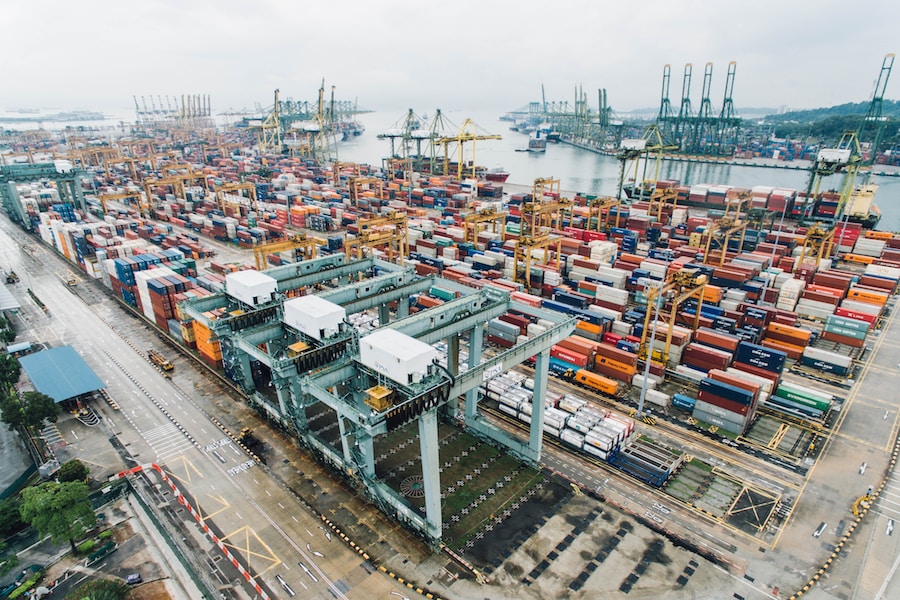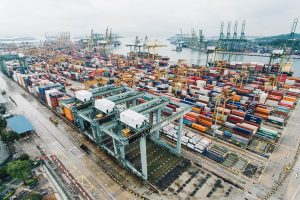Shipping alliances are cooperative agreements between shipping companies that allow them to pool their resources and share costs in order to improve efficiency and competitiveness in the industry.
The Big Three Shipping Allainces refers to the three largest shipping alliances in the world: 2M, Ocean Alliance, and THE Alliance.
The 2M alliance is a partnership between Maersk Line, the world’s largest container shipping company, and Mediterranean Shipping Company (MSC), the second largest. Together, they control a significant portion of the global container shipping market. The Ocean Alliance consists of CMA CGM, COSCO Shipping, Evergreen Line, and OOCL. Lastly, THE Alliance is made up of Hapag-Lloyd, ONE (Ocean Network Express), and Yang Ming.
The History of The Big three shipping alliances: How Did They Come to Be?
Shipping alliances have a long history, dating back to the 19th century when companies began to cooperate in order to share costs and improve efficiency. However, it was not until the late 20th century that the concept of global shipping alliances began to take shape.
The formation of this three shipping alliances can be traced back to a series of key events in the shipping industry.
- In 2014, Maersk Line and MSC announced their intention to form a strategic alliance known as 2M.
- This was followed by the formation of the Ocean Alliance in 2016, which brought together four major shipping companies.
- THE Alliance was also formed in 2016 as a response to the consolidation happening in the industry.
The Benefits of Shipping Alliances: Why Do Companies Join Forces?
There are several benefits that shipping companies can gain from joining forces through alliances:
- Cost savings through economies of scale: By pooling their resources and sharing costs, companies can achieve economies of scale and reduce operating expenses. This includes sharing vessel capacity, consolidating routes, and optimizing port calls.
- Increased efficiency and productivity: Shipping alliances allow companies to streamline their operations and improve efficiency. This can be achieved through better coordination of schedules, optimized vessel utilization, and improved port operations.
- Access to new markets and routes: By joining forces, companies can expand their network and gain access to new markets and routes. This allows them to offer more comprehensive services to their customers and increase their market share.
- Improved service quality: Shipping alliances can lead to improved service quality through better coordination and collaboration. This includes faster transit times, more frequent sailings, and enhanced customer service.
The Big Three Members: Who are They and What Do They Offer?
The Big Three alliances consist of several major shipping companies, each with their own strengths and weaknesses:
- 2M Alliance: The 2M alliance is made up of Maersk Line and MSC. Maersk Line is the largest container shipping company in the world, with a fleet of over 700 vessels. MSC is the second largest, with a fleet of over 500 vessels. Together, they offer a comprehensive network of services covering all major trade routes.
- Ocean Alliance: The Ocean Alliance consists of CMA CGM, COSCO Shipping, Evergreen Line, and OOCL. CMA CGM is the third largest container shipping company in the world, while COSCO Shipping is the fourth largest. Evergreen Line and OOCL are also major players in the industry. The Ocean Alliance offers a wide range of services covering all major trade routes.
- THE Alliance: THE Alliance is made up of Hapag-Lloyd, ONE (Ocean Network Express), and Yang Ming. Hapag-Lloyd is the fifth largest container shipping company in the world, while ONE and Yang Ming are also significant players in the industry. THE Alliance offers a comprehensive network of services covering all major trade routes.
The Impact of The Big Three on the Shipping Industry: How Have They Changed the Game?
The formation of The Big Three has had a significant impact on the shipping industry:
- Changes in market share and competition: The Big Three alliances control a significant portion of the global container shipping market. This has led to a consolidation of market share and increased competition among shipping companies.
- Impact on pricing and rates: The formation of alliances has led to changes in pricing and rates in the industry. While alliances can lead to cost savings and efficiencies, they can also result in reduced competition and higher prices for customers.
- Changes in vessel sizes and capacity: The Big Three alliances have led to an increase in vessel sizes and capacity. This is driven by the need to achieve economies of scale and reduce operating costs. Larger vessels can carry more cargo, resulting in lower transportation costs per unit.
- Impact on ports and infrastructure: The formation of alliances has also had an impact on ports and infrastructure. Ports need to be able to handle larger vessels and increased volumes of cargo. This has led to investments in port infrastructure and the development of new terminals.
The Challenges of Shipping Alliances: What Are the Risks and Limitations?
While shipping alliances offer many benefits, there are also several challenges and risks involved:
- Regulatory challenges and antitrust concerns: Shipping alliances are subject to regulatory scrutiny and antitrust laws. There is a risk that alliances could be seen as anti-competitive and result in reduced competition in the industry.
- Operational challenges and coordination issues: Shipping alliances require a high level of coordination and collaboration among members. This can be challenging, especially when members have different operating procedures and cultures.
- Risks of overcapacity and market instability: The formation of alliances can lead to overcapacity in certain trade lanes, which can result in market instability and lower freight rates. This can be particularly challenging during periods of economic downturn.
- Challenges of balancing the interests of different members: Shipping alliances consist of multiple members, each with their own interests and priorities. Balancing these interests can be challenging and may require compromise and negotiation.
The Future of The Big Three: What Can We Expect in the Coming Years?

The future of The Big Three alliances is uncertain, but there are several trends and factors that could shape their development:
- Potential for further consolidation and expansion: There is a possibility that the alliances could undergo further consolidation or expansion in the future. This could be driven by the need to achieve greater economies of scale and compete more effectively in the market.
- Impact of geopolitical and economic factors: Geopolitical and economic factors, such as trade tensions and changes in global trade patterns, could have a significant impact on the alliances. This includes potential changes in trade routes and shifts in market demand.
- Potential for new technologies and innovations: The shipping industry is undergoing a digital transformation, with new technologies and innovations being adopted. This includes the use of digital platforms, data analytics, blockchain, and IoT. The alliances will need to adapt to these changes in order to remain competitive.
- Challenges and opportunities for sustainability and environmental responsibility: The shipping industry is under increasing pressure to reduce its environmental impact and adopt more sustainable practices. The alliances will need to address these challenges and find ways to improve their environmental performance.
The Role of Technology in Shipping Alliances: How Are They Adapting to the Digital Age?
The Big Three alliances are embracing technology and adapting to the digital age in several ways:
- Use of digital platforms and data analytics: The alliances are using digital platforms and data analytics to improve their operations and decision-making processes. This includes optimizing vessel utilization, improving port operations, and enhancing supply chain visibility.
- Adoption of new technologies such as blockchain and IoT: The alliances are exploring the use of new technologies such as blockchain and IoT to improve efficiency and transparency in the industry. This includes the use of smart contracts, digital documentation, and real-time tracking of cargo.
- Potential for automation and unmanned vessels: The alliances are also exploring the potential for automation and unmanned vessels. This includes the use of autonomous ships and drones for cargo handling and delivery.
- Impact on supply chain visibility and efficiency: The use of technology in shipping alliances is improving supply chain visibility and efficiency. This allows companies to track their cargo in real-time, optimize their inventory levels, and improve their overall supply chain performance.
The Global Reach of The Big Three: How Do They Affect Trade Around the World?
The Big three shipping alliances have a significant impact on trade around the world:
- Impact on global trade flows and patterns: The alliances influence global trade flows and patterns by offering comprehensive services covering all major trade routes. This includes facilitating trade between different regions and connecting developing economies with established markets.
- Role in facilitating trade between different regions: The alliances play a crucial role in facilitating trade between different regions. They provide the infrastructure and services necessary for goods to be transported efficiently and cost-effectively across borders.
- Impact on developing economies and emerging markets: The alliances have a significant impact on developing economies and emerging markets. They provide access to new markets and routes, which can stimulate economic growth and development.
- Potential for geopolitical tensions and conflicts: The alliances can also contribute to geopolitical tensions and conflicts. This includes disputes over trade routes, competition for market share, and conflicts of interest between different members.
Conclusion: The Big Three and the Future of Shipping Alliances.
In conclusion, The Big three shipping alliances have transformed the shipping industry by pooling resources, sharing costs, and improving efficiency. They offer several benefits to companies, including cost savings, increased efficiency, access to new markets, and improved service quality. However, there are also challenges and risks involved, such as regulatory concerns, operational challenges, and market instability.
The future of The Big Three alliances is uncertain, but there are several trends and factors that could shape their development. This includes further consolidation and expansion, the impact of geopolitical and economic factors, the potential for new technologies and innovations, and the challenges and opportunities for sustainability and environmental responsibility.
Overall, the shipping industry is undergoing a digital transformation, and the alliances are adapting to the digital age by embracing technology and adopting new practices. This includes the use of digital platforms, data analytics, blockchain, and IoT.
The alliances have a significant impact on global trade flows and patterns, facilitating trade between different regions and stimulating economic growth. However, they also have the potential to contribute to geopolitical tensions and conflicts. It is important for shippers, carriers, and other stakeholders to stay informed and adaptable in a rapidly changing landscape.


